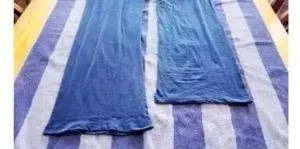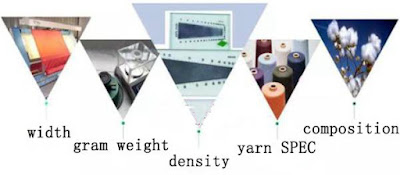Notes of Textile Colorfastness to Laundering of AATCC 61 Test Method
In order to better understand and apply the standard AATCC 61 “Colorfastness to Laundering of Textiles: Accelerated”, taking into account daily work experience and relevant literature, this paper will present a more systematic and comprehensive overview of the notes in the testing of the colorfastness of textiles to laundering.
AATCC 61 daily work for testing the colour fastness of textiles to laundering
In the daily work for testing the colour fastness of textiles to laundering using the AATCC 61 test method, the main elements include the following.
1 Samples are taken from the samples provided by the sender to prepare the combination specimens required by the standard. Based on the information about the product and the relevant standards, select the adjacent fabric and prepare combination specimens for testing.
Specimen size: 50x100mm for test No. 1A, 50x150mm for tests No. 1B, 2A, 3A, 4A, 5A.
2 Adjust the temperature of the water bath in the washing fastness tester to the specified requirements, configure the washing solution according to the table below and preheat the bath to the specified temperature. The specific test conditions are shown in the table below.
Test Conditions
3 Complete the procedure for the test method, measuring the mass of the combined specimen and adding soap according to the bath ratio, then setting the parameters of the washing fastness tester according to the test conditions for the test method and finally rinsing the washed combined specimen, squeezing out excess water and hanging it to dry.
4 Scales for rating test results: By comparing the original specimens and using a gray scale or spectroscopic colourimeter, the number of colour change levels of the specimens in the combined specimen and the number of staining levels of the adjacent fabric is assessed.
5 Produce the test report required by the standard and the information required by the standard is entered into the report template to produce a complete test report.
Notes for testing textile colorfastness to laundering of AATCC 61
In order to improve the accuracy and reliability of the test results, this paper will analyse and explore various aspects such as preparation of combined specimens, operation procedures, rating and issuing reports, this gives a more systematic and comprehensive overview of the notes for testing the colour fastness of textiles to laundering.
1 Notes for the preparation of combination samples
In order to avoid improper sampling and to standardise the preparation of combination specimens, the following notes should be taken in the preparation of combination samples.
During the preparation of the combined specimen, a representative part of the fabric should be selected (avoiding creases and faults) and a specimen of the specified size should be cut.
When samples contain patterns or multiple colours, a sufficient number of specimens should also be tested separately to ensure that all colours are included in the tested area of the specimen.
It is recommended that knitted fabrics be sewn or stapled at the four edges to equivalent size pieces of bleached cotton test fabric to avoid rolled edges and to assist in obtaining a uniform test result over the entire surface. Attach the multifiber test fabric to the face of the knitted fabric.
2 Notes for operating procedures
In order to prevent mistakes in the actual operating procedure from affecting the results of the color fastness test to washing, and to standardise the operation, the following notes are proposed for the operating procedure:
Preheat the configured soap solution, during this process, it is important to avoid air bubbles in the prepared soap solution that may affect the accurate measurement of the solution. In addition, verify whether steel ball is needed to be added in the test process and ensure the air tightness of the stainless steel container according to the corresponding test conditions and the relevant requirements of the supplier.
When switching on the washing machine, check the initial state of the washing fastness tester, set the parameters (corresponding test temperature and test time, etc.). During washing, attention should be paid to whether the washing colorfastness tester is in normal operating condition.
When operation is stopped, check that no water has entered the stainless steel container in the washing fastness tester. When water enters the stainless steel container in the washing fastness tester, a new sample should be taken and tested to ensure the accuracy of the results.
When removing the combination sample, remove all stitching from heavy and heavily discolored specimens and hang dry them separately from the adjacent fabric to avoid dye migration leading to uneven staining of the adjacent fabric after drying, and record the details of this.
During the rinsing of the combination specimen, it should be rinsed well enough to minimise the possibility of soap scum and white spots on the fabric surface affecting the grading results.
After squeezing the excess water from the combination specimen, the specimen should also be placed between two sheets of filter paper and squeezed to remove excess water to minimise the possibility of thermophoretic migration of the dye.
When hanging specimens to dry with clamps, the clamps should avoid the patterned part of the specimen, which prevents the clip marks left on the specimen from affecting the rating results.
3 Notes for evaluation
The evaluation should be carried out in a standard Color Matching Cabinet using AATCC scales (gray scale for color change, gray scale for staining, AATCC 9-step chromatic transference scale) for gaze grading. The assessor should wear a neutral grey coat and assess the color change of the specimen and the staining of the adjacent fabric in strict accordance with AATCC Assessment Procedure 7. Samples that fail, have uneven discolouration of the specimen, uneven staining of the adjacent fabric and other abnormalities, which should be re-sampled for testing and multi-person rating, and all abnormalities and details of the test should be described and recorded.
4 Notes for issuing the report
In the process of issuing the test report, accurately record the data obtained from the test, paying particular attention to and recording details of deviations from the standard AATCC 61 “Colorfastness to Laundering of Textiles: Accelerated Method” and any anomalies during the test, which ensure the accuracy and completeness of the data in each test report.
Conclusion and recommendations
In order to successfully complete the testing of the colour fastness of textiles to washing, the professionals should understand the above-mentioned considerations in this article and apply them in their daily testing work.
In addition, for testing institutes or laboratories with the ability to test the colour fastness of textiles to laundering, it would be best if the following 5 points could be achieved.
Operating procedures should be written and implemented according to the actual instruments used, such as washing fastness testers, standard light boxes and other relevant instruments.
Inspection rules related to colorfastness test for washing and colourfastness ratings for textiles should be prepared and implemented according to the daily workflow.
Strengthen learning and training to master the content of relevant standards, operating procedures of instruments, and inspection rules for daily work.
Reasonable arrangement of cleaning and maintenance of instruments. Standardise the management of reagents, adjacent fabrics and other consumables..
Strictly standardise test operations to improve the accuracy and reliability of test results and effectively ensure test quality.





评论
发表评论